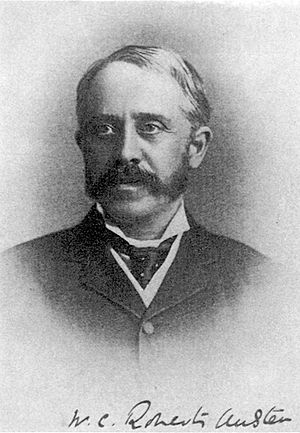William Chandler Roberts-Austen facts for kids
Quick facts for kids
William Chandler Roberts-Austen
|
|
|---|---|
 |
|
| Born | 3 March 1843 |
| Died | 22 November 1902 |
| Awards | |
Sir William Chandler Roberts-Austen was an English scientist. He was known for studying metals and their mixtures. These mixtures are called alloys. He researched how metals behave. A special type of iron alloy, called austenite, is named after him.
Contents
Who Was William Roberts-Austen?
Early Life and Education
William Chandler Roberts was born on March 3, 1843. He was born in Kennington, England. His parents were George and Maria Roberts.
Later, in 1885, he changed his name. He became William Chandler Roberts-Austen. This was a request from his uncle. It was a condition to receive an inheritance. William studied at home. Then he went to the Royal School of Mines. He studied there from 1861 to 1865.
A Career in Metals
William Roberts-Austen became a chemist at the Royal Mint in 1869. The Royal Mint is where coins are made. He later became a professor. He taught about metals at the School of Mines in 1880. From 1882 to 1902, he was the chief chemist at the Royal Mint.
He created ways to test alloys. He also invented a special device. It was an automatic recording pyrometer. This device helped measure temperatures. It recorded changes in hot furnaces and melted metals. He became a world expert. He knew a lot about making coins. His work helped many industries.
Awards and Recognition
William Roberts-Austen was chosen for the Royal Society in 1875. This is a very important science group. He gave a special lecture for them in 1896. He received several honors. He was made a CB in 1890. He was knighted in 1899. This means he became "Sir William." He also received an award from France. It was called the Legion d'honneur.
Later Life
Sir William helped build a chapel in Blackheath, Surrey. This was in 1893. He passed away at his home. His home was at the Royal Mint. He was buried in Canterbury, Kent. He had married Florence Maude Alldridge in London in 1876.

